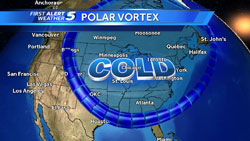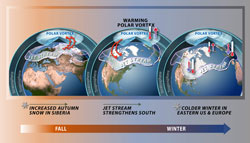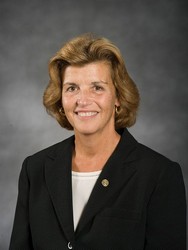This past January, temperatures in the Garden State dropped below freezing and on some days it was colder in New Jersey than it was in Greenland or Antarctica. The culprit? Meteorologists are blaming the polar vortex, a low pressure system affecting the Nation.
There are various explanations associated with the reoccurring weather patterns forming. One explanation for this year’s surge of arctic cold weather is due to the extension of the polar vortex dipping into North America, creating below freezing temperatures throughout the nation.
A polar vortex is a semi-permanent low pressure system over the North Pole and South Pole that exists year-round, Paul Gaffney, meteorologist and former University president, said. “In this case I believe a stronger jet stream at high altitude dipped down into the Midwest and to the East Coast bringing with it cold air from northern Canada.”
There is more than one polar vortex that exists. The polar vortices, according to weather.com, are low pressure weather systems that commonly remain in the Northern hemisphere, typically over Baffin Bay in Canada and Northeast Siberia.
The polar vortices are created from the sun’s rays emitting heat on the earth which rises up to the Northern hemisphere and eventually reaches the North Pole, Kayla Lewis, an associate professor in chemistry, medical technology and physics, explained. Once the hot air hits the North Pole, the air begins to circulate, creating masses of cold air in the atmosphere that hovers over Canada and Siberia.
“The hot air that goes up has to be replaced by other air or it would just be a vacuum there at the equator,” said Lewis. “So the hot air rises because it’s hot, this air comes to replace it and that’s what forms this [mass of cold air].”
Lewis further explains that because the earth rotates, the mass of air is broken up into different masses, called Hadley cells, and the cells are moving in different circulating directions.
 “They’re kind of like gears the way they turn,” said Lewis. “That’s because when the earth is rising, it is rising with this force called the Coriolis force, which makes things seem like they have a force and want to veer off path.”
“They’re kind of like gears the way they turn,” said Lewis. “That’s because when the earth is rising, it is rising with this force called the Coriolis force, which makes things seem like they have a force and want to veer off path.”
Between the Hadley cells are jets of fast moving air, called a jet stream, Lewis explained. There are two jet streams that exist, the subtropical jet stream and the polar jet stream.
Jet streams are currents of air high above the Earth, according to National Geographic. They move eastward at altitudes of about eight to 15 kilometers (five to nine miles), and form where large temperature differences exist in the atmosphere.
“They form because the sun heats the Earth unevenly,” National Geographic states. “As the Earth is heated, it warms the air just above it … Cooler, heavier air then pushes in to replace the warm air, forming a cool air current.”
Lewis explains that the jet streams separate cold air and warm air. “…As [the jet stream] was pinching down, another part of the jet stream was pinching upward and it made temperatures elsewhere warmer than they would have been,” said Lewis.
Because the cold air in the jet stream moved towards North America, the warm area of the jet stream was closer to Antarctica and Greenland. “So the U.S. was freezing but you could go to Greenland and it would have been more pleasant there,” said Lewis.
According to weather.com, the jet stream was forced south due to a ridge of high pressure, causing central and Eastern America to continue to experience freezing temperatures while the West coast was in a draught. These cold temperatures are capable of plunging as far South as Florida.
“You will note that it has been warm west of the Rockies and colder in the Eastern half of the U.S.,” Gaffney said. “Generally the jet stream that helps ‘steer’ temperatures has looked like a roller coaster with the high point on the US West coast after which the stream dips through the Midwest toward the US Southeastern states.”
Gaffney said, when this pattern stagnates as it has, the Eastern area receives colder and stormier weather. Although the pattern did not change much in January, he added.
The Asbury Park Press (APP) reported that the consistent cold weather may be a result of the jet stream getting locked. “A wavier jet stream ‘can get locked in more easily, so you get these extremes because you lock it in long enough’ to produce drought, heat waves, wetness and cold in some cases,” David Robsinson, the New Jersey state climatologist at Rutgers University, told APP.
Robsinson also stated that the “wavier” jet stream theory has some legitimacy, although is not universally accepted.
There are various theories that explain why the polar vortex and jet stream veered into North America this winter. Some weather outlets, including APP, reported that the polar vortex dipped into North America several times.
Many scientists believe that the cause may be due to climate change directly related to global warming. Lewis explains that due to the research she has discovered linking to global warming, she believes that this may have been the cause to polar vortex’s extension into North America.
“What’s happening is the Polar Regions are losing their ice and ice reflects sunlight back into outer space,” said Lewis.
Lewis explained that if you were to look at the Polar Regions from outer space you are able to see the white from the ice caps, which means the light is being reflected into outer space. “Which is a cooling effect because you are not absorbing the energy of the sunlight, you are sending it back into space,” said Lewis.
Although, if the ice is melted and the sunlight is absorbed instead of reflecting it back into space, the temperatures in the Polar Regions are warmer, said Lewis. “And the contrast between the poles and the tropical regions is less than it would be otherwise,” she added.
As a result of the decreased contrast between the North and South Pole, the jet streams over the earth can become “wobbly” and can force “things to break off,” Lewis added.
Lewis also said that as a result of this change, movement of the polar vortex and jet stream may happen more often than previous instances.
This belief is not shared among all scientists. Many also believe that the cold weather is simply the result of a season change. “We have to look at much longer periods, make better observations of the environment and improve our long range mathematical forecasts before we can try to link such single events to climate change,” said Gaffney.
Gaffney explains that though the winter has been difficult due to the polar vortex bringing cold air into North America for nearly a month, he believes the roller coaster weather pattern is flattening out. “This keeps the colder air moving from West to East in the Northern states with warmer air staying in the south,” said Gaffney. “New Jersey is on the border and that means a bit of moderation in temperatures…”
The surge of cold air is not only causing freezing temperatures in New Jersey, it is creating cold, snow-filled weather systems nationwide. States across America have been forced to battle icy roads, difficult commutes, accidents and numerous school closures.
The University has had to close school on two occasions due to snow fall. The first snow storm of the spring 2014 semester was on Tuesday, Jan. 21, and caused classes to be cancelled from 2:30 pm to Wednesday, Jan. 22 at 4:30 pm.
The second University cancellation occurred at 9:47 am. Patti Swannack, Vice President for Administrative Services said in an email, “Please be advised that Monmouth University is cancelling classes beginning at 10 am or later on Monday, February 3, 2014.”
This created an issue for students and faculty members traveling to school for10:00 classes. “I parked, sat in my car and checked my email at 9:32,” said Rebecca Zidik, a junior communication major. “Then as I walked in the building I found out that class was cancelled.”
Zidik explained that as she drove to campus during the snowfall on Monday, Feb. 3, she felt as though she was risking her life and was extremely disappointed that classes were not cancelled sooner.
Other students had similar complaints about the weather conditions and time of cancellation. “As a commuter I was extremely disappointed to arrive on campus after a dangerous two hour drive just to find out that classes were cancelled last minute,” said Kelly Ivan, a freshman education major.
Swannack explained that the process of closing school due to weather related conditions takes into consideration many factors, involves many people and takes time to be done correctly.
Swannack must first contact the University Police Department for updated storm information issued by the NJ State Police. Secondly, she must contact the University personnel responsible for clearing snow. Thirdly, she contacts the Vice President of Student Life and Leadership Engagement to determine if there are any special events on campus, and the person that makes the ultimate decision of whether school will be cancelled or not is the Thomas Pearson, Provost and Vice President for Academic Affairs.
Swannack explained that on Monday, Feb. 3, school was closed at 9:47 am because the University originally planned to close at 11:15 am. “We planned to close at 11:15 am (the end of the next academic frame) but because the conditions seemed to be deteriorating faster than what was predicted, we decided to allow students and employees to leave as soon as possible,” Swannack explained.
As a result, the recent weather conditions have caused numerous issues nationwide including the massive pileup I-94 outside of Chicago that killed three people and injured 20.
These snowy, cold conditions are not done either. The Farmer’s Almanac predicts that the month of February will experience many more snowy and rainy conditions. The Farmer’s Almanac states, “Winter will be colder and drier than normal, although snowfall will be above normal in most of the region,” also stating that the snowiest periods will be in early and mid-February.
IMAGE ADAPTED from thenationalsciencefondation.gov
IMAGE TAKEN from koco.com




